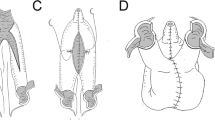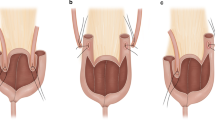Summary
From April 1986 through May 1995, 306 men with primary urothelial carcinoma underwent radical cystoprostatectomy and orthotopic bladder substitution via the ileal neobladder. Altogether, 7.5% of the patients suffered general early complications, including thrombosis, embolism, wound infection, and pneumonia. Specific early complications directly related to formation of the neobladder and requiring surgery included ileus (4%), abscess drainage (2%), and leakage of the ileal anastomosis (0.5%). The early reoperation rate was 6.5%. Early complications that required temporary percutaneous drainage were lymphocele formation (3%) or ureteral obstruction (6%). In all, 9% of our patients required prolonged catheter drainage for leakage of the ileouretheral anastomosis. Late complications requiring reoperation were ileus (2%), abscess drainage (1%), neobladder fistula to the colon (1,5%), ureteral reimplantation because of obstruction (3.6%), and nephrectomy for hydronephrosis (1%). A transurethral incision of the ileoureteral anastomosis was necessary in 7% of cases. Continence was separately addressed by sending each patient and his home physician a detailed questionnaire: Using our criteria (no diapers, no awakenings) the night and day continence rate increased from 67% at 6 months, to 72% at 1 year, to 85% at 2 years, finally reacting 90% after 4 years. In part II of this presentation we address the question as to whether the option of orthotopic bladder replacement has any impact on the patient's and physician's decision toward earlier cystectomy. We compared our ileal neobladder cohort with a group of 137 patients that had been operated on during the same time span by the same group of surgeons. There was no negative selection with regard of the tumor stage of our patients. However, as compared with the conduit group, the neobladder cohort had a significantly improved survival rate. This phenomenon is explainable by the significantly lower number of previous transurethral resections of the bladder (TUR-Bs) performed in the neobladder group. The time span between primary diagnosis and cystectomy was 10 months in the neobladder group as compared with 18 months in the conduit patients. These data reinforce our belief that orthotopic bladder replacement using the ileal neobladder yields an extraordinary functional result that can be accomplished with a high degree of patient satisfaction and minimal complication. The availability of orthotopic bladder replacement does indeed stimulate the physicians and patients decision toward earlier cystectomy.
Similar content being viewed by others
References
Bachor R, Frohneberg D, Miller K, Egghart G, Hautmann R (1990) Continence after total bladder replacement: urodynamic analysis of the ileal neobladder. Br J Urol 65:462
Hautmann R, Egghart G, Frohneberg D, Miller K (1987) Die Ileum-Neoblase. Urologe [A]26:67
Hautmann R, Egghart G, Frohenberg D, Miller K (1988) The ileal neobladder. J Urol 139:39
Hautmann R, Miller K, Steiner U, Wenderoth U (1993) The ileal neobladder: 6 years of experience with more than 200 patients. J Urol 150:40
International Continence Society Committee on Standardization of Terminology (1988) Editorial. Scand J Urol Nephrol [Suppl] 114:5
LeDuc A, Camy M, Tulla P (1990) An original antireflux ureteroileal implantation technique: long-term follow-up. J Urol 144:864
Martins FE, Bennett CJ, Skinner DG (1995) Options in replacement cystoplasty following radical cystectomy: high hopes or succesful reality? J Urol 153:1363
Miller K, Bachor R, Frohneberg D, Egghart G, Hautmann R (1990) Kontinente Harnableitung beim älteren Menschen. Urologe [A] 29:87
Steiner MS, Morton RA, Walsh PC (1991) Impact of anatomical radical prostatectomy on urinary continence. J Urol 145:512
Studer UE, Spiegel T, Casanova GA (1991) Ileal bladder substitute: antireflux nipple valve or afferent tubular segment? Eur Urol 20:315
Wenderoth UK, Bachor R, Egghart G, Frohneberg D, Miller K, Hautmann R (1990) The ileal neobladder: experience and results of more than 100 consecutive cases. J Urol 143:492
Author information
Authors and Affiliations
Rights and permissions
About this article
Cite this article
Flohr, P., Hefty, R., Paiss, T. et al. The ileal neobladder — updated experience with 306 patients. World J Urol 14, 22–26 (1996). https://doi.org/10.1007/BF01836340
Issue Date:
DOI: https://doi.org/10.1007/BF01836340




